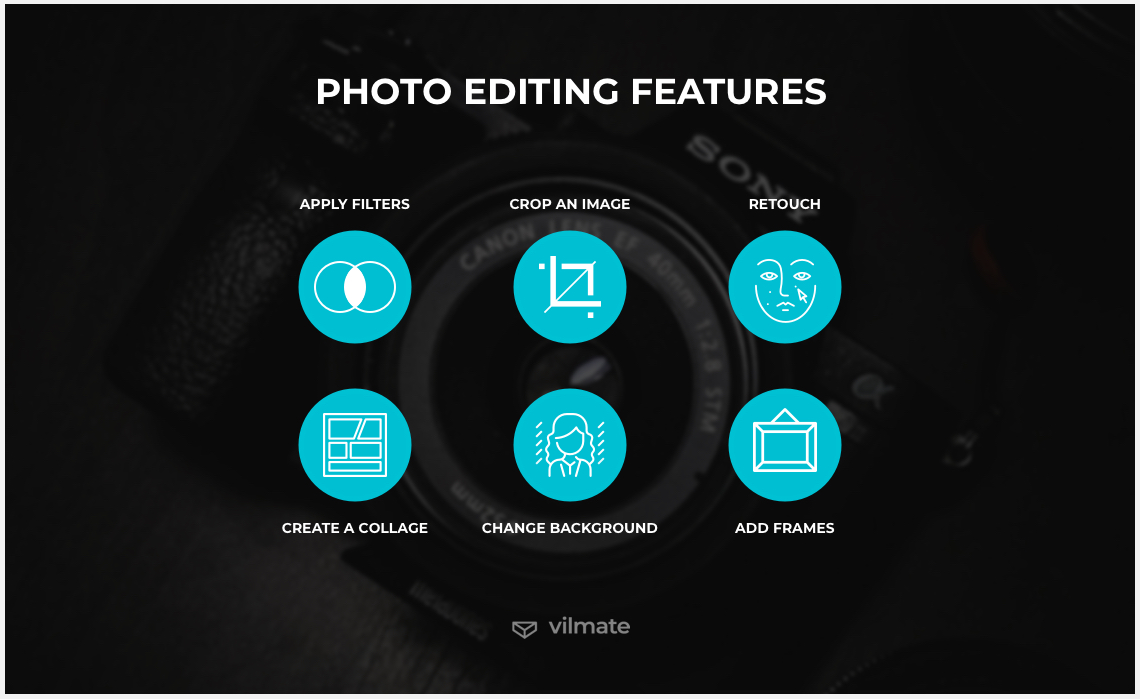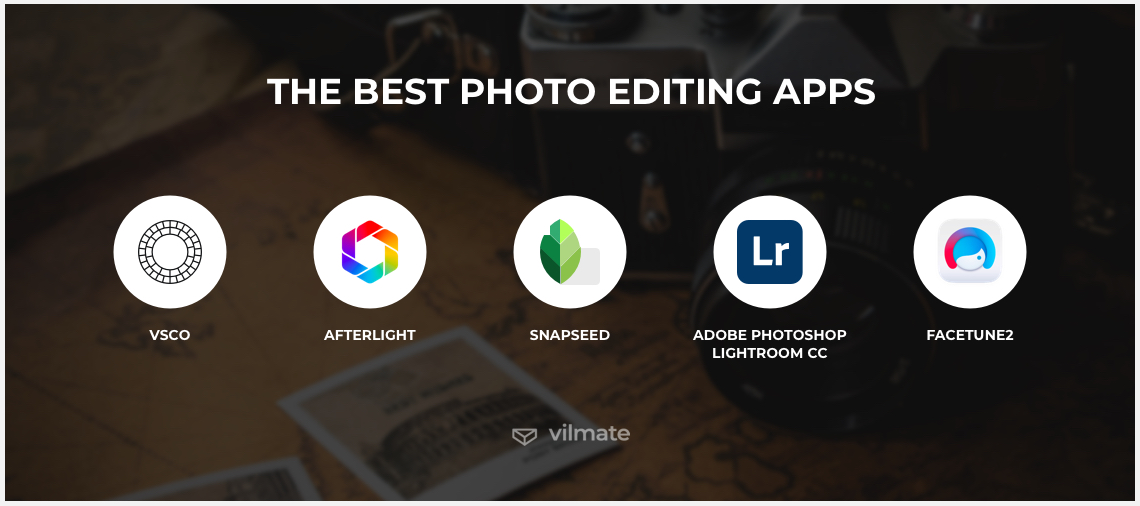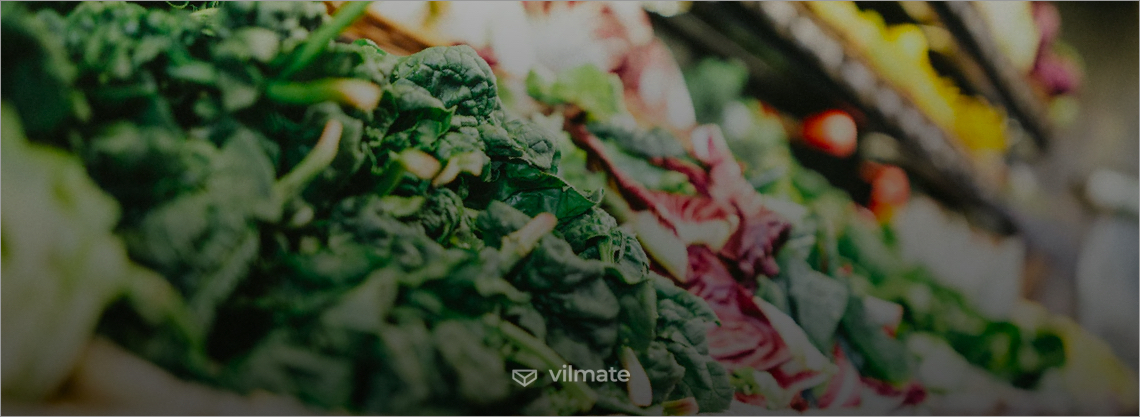In the 21st century, photography has become one of the principal online digital means of communication. With a smartphone and a photo editor app installed on it, anyone is empowered to express themselves through art and, at the same time, communicate their messages in an exciting and concise fashion.
Photo editing is what transforms an amateur photographer into an artist. What app a person uses to make photo edits matters just as much as what art tools a painter is equipped with to create his or her masterpieces. The best-quality software will enable you to do magic by applying filters and effects and eventually leave you satisfied with what came out.
If you wonder how to make a photo filter app for iOS and Android users so that to meet their needs, wants, and wishes, our article is here to help you out! We’ve gathered the most up-to-date information about photo editing software and are happy to share our findings with you. What types of apps are there on the market, what features your photo editing app won’t do without, what technologies are a must to make your application real good, and what industry leaders one should seek inspiration from – no secrets will be left out.
Types of photo editing apps
Before segueing off to discussing such nuances as the tech stack and photo editing app features, let’s first find out what types of photo editor applications one can most often come across when browsing app stores. On average, a distinction is drawn between regular and social photo editor applications. And it will be reasonably hard to say which app is best for editing pics as the answer will always depend on what goals either a developer or an end-user pursues. Which type one chooses, in turn, will influence the way an MVP will be built, what the team composition will be required, and how the whole software development process will be organized.
1. Regular photo editing apps
To begin with, the difference between the two is not too drastic in terms of functionality, but it is much more noticeable in terms of the ideology behind them. A regular photo editing app will most probably be focused on the capacity of editing capabilities. The instant examples include Adobe Photoshop Lightroom, Google Snapseed, Retrica, and Prisma, some of which we are going to discuss in more detail below. They are made solely for the purpose of editing and saving photos or videos. However, the selection of such apps is nearly comprehensive on the market: from basic editing apps that one’s granny will be able to quickly find her way around to more elaborate offerings that are better suited for professional use. The pricing varies correspondingly, so it is quite a challenge to find one’s niche and balance out the app capabilities with its cost correspondingly.
2. Social photo editing apps
A social photo editing app typically has a social component that lets users chat with each other, share photos with friends in there, create communities, or even become influencers whose art provokes interest in fellow photographers and art lovers. The VSCO app is exactly like that.
However, VSCO experience per se, and especially if compared to the user experience of other photo editing and sharing platforms like Instagram, is structured less like social media. Instead, a sense of belonging is the platform’s commercial product. As a VSCO user, one cannot like or comment on publications, neither can people see other users’ follower count. The app is more like a community of users and influencers, which is neither good nor bad. The market for social photo editing applications must be diverse. If Instagram or other social networks like Instagram offer tools for effectively maintaining particularly binding interactions through photo-sharing, the VSCO app is subscription-based and gives users space for creativity and provides support for their mental health. The latter app is monetized not through selling ads or customer data but through selling the feeling for privacy, transparent relationship with a social platform, and the focus on the creative community.
Must-have features you need to add to your photo editor app
The project scope for the photo editing app depends on what and how many features are planned to be developed. One way or another, a photo editor must be able to modify and improve images in ways users expect them to. These are must-have basic features, and we are going to look into the matter and see what makes a photo editing app in the first place.
1. Upload a photo
First and foremost, every photo-editing app must-have is an image-uploading feature. For that to happen, an app must have access to either a camera or a gallery. This may be required for submitting a profile photo, adding images to blog posts, or uploading pictures to edit them. We will cover the technical side of the issue later in this article, so stay tuned!

2. Use photo editing tools
Now, we’ve got to the point – the app’s editing capabilities. The more of them you add, the better. But always ensure that those features are there not only for the sake of appearances but in the first place, to empower users to correct pictures in a qualitative manner. In other words, each feature must be refined down to the last detail.
-
Apply filters - the best photo editing apps offer their own sets of filters to users. These filters should be recognizable, but what is even more important useful and satisfying. The functioning principle of the photo-editing filters is something that one has to understand to create a great photo app. Basically, filtering deals with either pixels or layers of an image. Examples of layer processing include photo editor effects like gradient, grain, color attenuation, or lightening. Color temperature, saturation, and tinting are all pixel processing. As a result, a filter effect is applied to either of the two or both of them as a preset modification with the aim to enhance an image.
-
Crop an image - and also flip, rotate, resize, and straighten. This is the group of editing tools that deals with an image as a whole and not with its details. Let users easily remove portions of a photo and straighten it to create the focus in a shot and alter the image composition to make it look more pleasing. For cropping, you can offer a menu of fixed aspect ratios (like the rule of thirds, grid, and golden ratio) or allow customization. Transforming perspective and straightening a photo are two other great ways to improve composition when cropping an image.
-
Retouch - this editing tool is best suited for enhancing portrait photos or for professional use of an app. With the help of this function, a user should be able to edit photos and remove unwanted objects from them. A suit of retouching tools must be as comprehensive as to enable users to remove all the imperfections from an image. This function is still quite popular in today’s era of social media, as it allows removing blemishes and acne, whitening teeth, reshaping features, and adjusting skin tone. So, it’s merely a nice gesture to meet customers’ demands and make it easier for them to achieve their goals with your software. Even though being body positive and celebrating natural beauty has already become another big trend, the scope of application of photo retouching remains much wider than removing “defects” and will find its admirers anyway.
-
Create a collage - collage making in certain contexts can be considered an art form and a medium for creative self-expression. It is an appealing way to showcase one’s best photos in one picture. Some web and mobile applications include a collaging feature along with others like retouching, filtering, etc. The others make it the primary offering of their product, like the Pic Stitch app or the PicCollage Grid & Photo Maker application do. Either way, the app must provide such a set of tools that won’t require proficient editing skills from users and will allow them to quickly create a photo collage.
-
Change background - changing the background in a photo sounds not that simple. But it must be an easy thing to do for app users. There are a number of helpful photo background changer apps that focus on this particular feature and an even greater number of photo editing apps that enable changing background in addition to other image modifications. To change the background, a user has to be able to upload an image, crop the needed area, mark the background area they wish to cut, select a new background picture, and change it.
-
Add frames - borders and frames help make photos prettier or get the needed aspect ratio without having to crop parts of an image. One can offer a comprehensive library of frames and/or allow selecting an image from the phone gallery and thus creating the frame a user likes.
3. Save and share
The final step of the photo editing process is saving a picture in a gallery and/or sharing the result on a social media platform or a messenger. One may use, for example, an object storage API such as Amazon’s S3 or OpenStack’s Swift for storing and retrieving files. Also, fast and reliable photo and video sharing can be built into an app with the help of APIs that would help easily connect and share photos across multiple platforms.
Technologies to build top image editing software
What app enhances pictures best? Of course, the one that is built by a qualified team that used the right technology stack. Therefore, you should first ask not how to make a photo editing app in Android Studio or Xcode but what other technologies to use to make your photo editing app for Android and iOS useful and just awesome.
To begin with, one has to gather a project team for photo editing mobile app development. This team must include Android and iOS developers, a UI/UX designer, a QA engineer, a back-end developer, and in some instances, a business analyst and a project manager.
As we’ve already found out, image editing applications are feature-rich, and therefore, will generally require complex tech stack for development. Its composition is bound to vary depending on whether you plan to build a photo editing app for iOS, Android, or both, whether it is going to be focused on one feature, like collaging or background changing, or you want it to provide a full spectrum of editing services.
One way or another, there are going to be some basic principles to follow when choosing the tech stack for an image editing application. First of all, it is likely to extensively rely on application programming interfaces (APIs.) For example, OpenGL is one of the most widely used graphics APIs for developing photo editing apps for Android devices. As for the libraries, there’s a bunch of those for both Android and iOS. Say, PhotoEditor is an image processing library, compatible with the Android SDK, that offers easy support for many image editing features. On the other hand, OpenCV (Open Source Computer Vision) is an example of a library that provides support for both iOS and Android OSs.
Besides, APIs that are used to connect and share photos across platforms, like Instagram, Pinterest, Unsplash, or Flickr, has to be a must-have item on your list of technologies. Whatever the case, each application is unique, and its development must be approached individually. Our tech professionals are always ready to take the initiative and come up with a perfect technical solution for both creating an MVP of your product and developing a fully functional mobile app.
Examples of the best photo editing apps
The best photo editing apps for bloggers, kid-friendly photo editing software, image editing apps for designers or illustrators – the demand for all sorts of editing programs is tremendous nowadays. But what's the best photo editing app? To help you out with where to head for and who to seek inspiration from, we’ve compiled a list of the most popular, well-established applications that have managed to win hearts of hundreds of thousands and millions of users around the world.

1. VSCO - this is a freemium platform for photo and video editing. When the question of what is the easiest free photo editing software arises, VSCO is one of the first candidates to pop up in mind. It is also widely regarded as the best app for filters and is particularly popular among Instagram users. The application now has 4 million paying users, a total of 40 million monthly users, and 20 million weekly active users. For no cost, people can access a handful of basic VSCO filters, use standard editing tools, and view the content published by others in the app’s photo feed. Paying a subscription fee, they get access to the full editing tool-set, exclusive preset filters, and more.
- Platform: iOS and Android
- Developer: Visual Supply Company
- Price: an annual subscription fee of $19.99
2. Afterlight - Afterlight is one of the pioneers of photo editing apps that is present on the market since 2012. It is available as a free download but has a number of in-app purchasing options. The app has a clearly arranged user interface that is easy-to-navigate for the least experienced users. Its filters and classic editing tools are a good help in enhancing photos without making them look too unnatural.
- Platform: Android, iOS, and Windows
- Developer: Afterlight Collective, Inc.
- Price: free trial, a monthly subscription fee of $2.99, an annual subscription fee of $17.99, a lifetime membership fee of $35.99
3. Snapseed - this one is a freeware, which is the best Android app to edit images in the opinion of many people. It was initially developed by Nik Software to be subsequently taken over by Google. Now, it is available for Android- and iOS-based smartphones and tablets. Snapseed offers a wide variety of editing tools and filters that can be tweaked precisely. It was among the 100 best Android apps of 2018 and for a good reason. The application is both well capable of fixing a photo that is far from perfect and enhancing any picture with the most advanced edits.
- Platform: Android and iOS
- Developer: Google LLC
- Price: free
4. Adobe Photoshop Lightroom CC - that is the version of Lightroom that began to be supported on mobile devices in 2017 when software version 7.0 was officially released. Adobe Photoshop Lightroom is free to install but has a variety of in-app purchasing options. Among others, the platform offers a rich library of interactive tutorials meant to teach to edit photographs without sophisticated preset filters like a pro. Adobe Photoshop Lightroom CC has an extended tool-set that is used by photographers and artists to create their best images.
- Platform: Android and iOS
- Developer: Adobe Inc.
- Price: a breadth of subscription plans from $1.99/month to $49.99/annually
5. Facetune2 - Facetune is one of the most popular applications for portrait and selfie editing and all sorts of retouching. The first version of the application was developed in 2013 and is currently available on the App Store. Meanwhile, Facetune2 that was released in 2016 is available for both Android and iOS device owners. It is a more advanced version with somewhat more sophisticated tools for enhancing users’ photos. Besides, in 2020, the company launched a separate application for editing videos Facetune Video. Taking advantage of the power of artificial intelligence, it allows retouching moving objects.
- Platform: Android and iOS
- Developer: Lightricks
- Price: subscription plans varying from $1.99 to $35.99
How to make a photo editing app: Step-by-step guide
To sum up, let’s focus on how a photo editing application is developed step-by-step, what a software development lifecycle should be expected to look like.
- Research the market and familiarize yourself with competitors’ products, like the ones we mentioned above.
- Hire a project team. Consider contacting a software development outsourcing company to do the job.
- Prepare design and specifications for your future photo editing app, decide what features it will have.
- Choose the right technology stack to build a photo editor app.
- Create an MVP version of your app and then develop an actual mobile application for the OSs of your choice.
- Come up with an elaborate marketing strategy and the most suitable ways to monetize your application.
- Prepare for the app launch, release your photo editing app to the stores, and regularly update it.
Conclusion
As social media platforms become used by an ever-wider audience, there will remain the need for photo editing applications. They provide people with a relatively easy way to create and share fantastic visual content. Some of them are basic so that even a newbie will turn out quite good at photo editing. The others work better when used by professionals. So, there will always be people to use your product.
Now that you have gained all the essential knowledge on how to create a photo editing app, you need a reliable tech partner that will guide you along the way and support you at every stage of the photo-editing software development process. The Vilmate team has extensive experience in developing mobile applications for a variety of verticals. Have an idea? Contact us, and we’ll together get your project off on the right foot!

© 2020, Vilmate LLC




